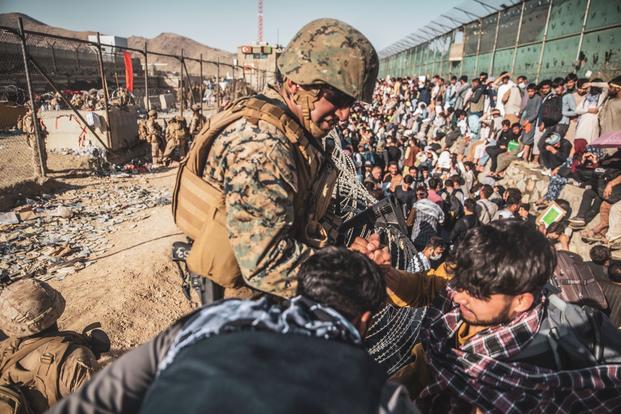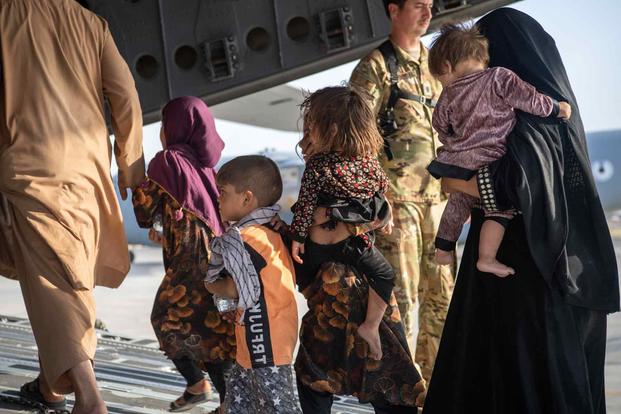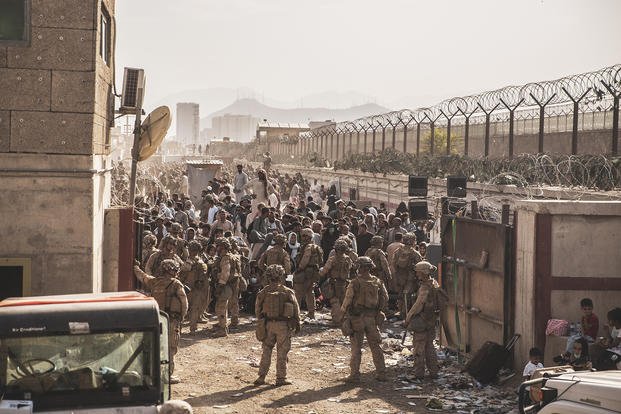My phone lit up a little before 9:30 a.m. Wednesday, with a call from Afghanistan. The number belonged to Said, an interpreter from Kabul who had worked for the U.S. military a decade ago.
But the voice on the other end of the phone wasn't Said's. An American Marine was urgently asking me who I was. I told him my name and identified myself as a reporter with Military.com. I asked whether Said was there and if they were at Abbey Gate, one of the main entrances to Hamid Karzai International Airport, which currently serves as the only way out of the country for many Afghans.
That day, like they had for more than a week, thousands of people -- primarily Afghans, but also Americans and other foreign nationals -- gathered outside the airport's gates, crying, pleading. They crowded shoulder to shoulder, some waving visas, passports or other documents they hoped would catch a sentry's attention at a checkpoint and get them waved through, closer to a flight to safety.
The Marine on the other end of the phone confirmed that's where they were. I asked how I could help.
"Give me one second," the Marine said. He called someone else over, a first lieutenant, and I could make out something like, "We got a Pentagon reporter here." I feared they might hang up immediately.
The lieutenant took the phone. "Are you able to vouch for [Said]?" he asked. I stammered for a few seconds, shocked that my voice could change the outcome of this potentially life-defining moment for Said. I found the words and said yes, my reporting had confirmed he was an interpreter for six years at the Craig Joint Theater Hospital at Bagram Airfield, and that I could vouch for him. He had a visa issued by the U.S., I added, as Said had sent me a copy.
"He has a visa?" the lieutenant repeated. The phone grew muffled. The lieutenant seemed almost apologetic. "It's a process I have."
An unidentified voice called out, "Where's the visa, though? Show me what you got."
There was more chatter, and I stayed quiet, listening. Then, I heard one of the Marines declare, "He hung up."
I panicked: "No, I'm still here! I'm still here!" I heard Said's voice in the background, sounding frantic, and then the line went dead.
Looking for a Way Out
Hundreds of thousands of people have sought to escape from Afghanistan in a matter of weeks, as the Taliban swept across the country and drove the U.S.-backed government in Kabul from power. Those seeking refuge include thousands of Afghans who worked for the United States government or military as interpreters or in other jobs over the last two decades.
The Taliban has targeted former interpreters or other allies for retribution, brutally killing some while threatening others. Many sought to receive the Special Immigrant Visas designated for those who had helped American forces in Afghanistan that would allow them to come to the United States, only to be stymied -- often for years -- by an incredibly slow, bureaucratic, understaffed system. Some advocates estimated the number of SIV applicants and their immediate family members who needed to escape to total between 70,000 and 80,000 people; President Joe Biden said last week his administration believed there were 50,000 to 65,000.
The New York Times reported Wednesday that the tally of Afghans eligible for expedited visa processing who still need evacuation is likely much higher, topping at least a quarter-million.
Nearly 112,000 people had been evacuated from Afghanistan since Aug. 14.

The volatile scene outside of Kabul's airport culminated Thursday morning in a suicide bombing at Abbey Gate, where Said had handed his phone to the Marine and so many had gathered pleading for a way out of the country. The bomb killed 13 U.S. troops and at least 170 Afghans, and wounded more than 20 U.S. troops and scores of Afghans. The Islamic State's Afghanistan branch claimed responsibility for the attack.
Said and I had been in regular communication since I profiled him for Military.com last month, as he desperately scrambled to get his long-awaited Special Immigrant Visa and extract his wife and six-month old daughter from Afghanistan as the Taliban quickly reclaimed the country.
Military.com is continuing to protect his identity and will not publish his full name, given ongoing security concerns in Afghanistan.
Said's WhatsApp messages grew increasingly troubled as city after city fell to the Taliban, and the group closed in on Kabul. His neighbors knew he had helped the United States, he said, and he worried someone might tell the Taliban what he had done. He repeatedly asked me to help him, but I didn't know what I could do.
One day, he texted me another photo of his infant daughter in a blue Mickey Mouse shirt and wrote, "My only concern is this child."
A father myself, I felt helpless.
I began to hear about informal groups of volunteers that were trying to help people escape Afghanistan, using hashtags such as #DigitalDunkirk. I made a few phone calls and sent emails to alert these groups that Said needed help and, with his permission, passed on information such as his SIV case number.
One group had dubbed itself Team America, sharing its name with the cult satire film about a paramilitary "world police" anti-terrorist force. It now numbers some 225 volunteers, including veterans, attorneys, everyday citizens and some current service members and government employees working on their personal time, using open-source information. The group also collects information submitted from contacts on the ground about Taliban movements, checkpoints, road conditions or other information that can help potential evacuees reach and get inside the airport safely.
Team America volunteer Minoo Razavi, who has organized the effort to advise Said, said that the group has so far succeeded at helping more than 200 people get out -- including U.S. citizens and green card holders who also are experiencing troubles with evacuations.
This is a "really tenacious, intrepid group of folks doing what, frankly, the U.S. government should be doing," Razavi said. "We shouldn't be doing this. None of us thought that, seven days ago, we would put our day jobs on the back burner, trying to do this humanitarian cause."
It's largely a roll of the dice determining whether someone can even reach the airport, let alone make it inside. A checkpoint, a shootout, Taliban beatings or tear gas outside of the airport -- all could halt an escape.
"It is chaos," Razavi said of all the information the group is struggling to process to help advise evacuees. "There is no rhyme or reason, and there's no order."
The group doesn't have networks of vans or vehicles shuttling evacuees. Instead, it uses "underground connections" to monitor conditions on the roads to advise them on the safest route to get to the airport and through the gate. There are also websites that compile real-time, crowdsourced information on road conditions.
Those conditions can change on a dime.
"Taliban are at [the airport's] Abbey Gate, and everyone [should go to the] civilian gate; five minutes later, we'd be like no, Taliban are at the civilian gate, everyone to Abbey Gate," Razavi said, describing how quickly their messages had to shift. "Extremely fluid situation."

Razavi said there was a massive chat group on WhatsApp including Said and about two dozen Team America volunteers advising him.
The group thought a window had opened late Saturday night on Aug. 21 (Sunday morning in Kabul) for Said to escape, with a safe route identified for him to drive and a contact ready at the gate to meet him and help him through. But the window closed as conditions grew more dangerous and rapidly shifting, conflicting reports on Taliban movements flooded in.
Said's concerns only compounded after missing that window, and he kept asking for help.
The evacuation effort also began to prioritize American citizens and green card holders, so Team America started to triage. The group shifted its focus to those evacuees it felt it could have the greatest luck getting out.
"Obviously, it was heartbreaking, but there was a payoff," Razavi said. "We have a limited number of resources, and we saw that the more successful cases were, for example, the American citizens and green card holders."
Team America began to grow less and less comfortable telling people, especially those with young children or otherwise vulnerable members, where they should go. The group began to tell potential evacuees, including Said, it couldn't advise them when and where to go, and they would have to make those decisions for themselves.
The Escape
Earlier Wednesday morning, Said texted to let me know he was making a run for the airport. Ten days had passed since the Taliban had seized Kabul, and less than a week remained before the U.S. military planned to get its troops, equipment and all the evacuees it could out ahead of the Aug. 31 deadline.
There had been increasing reports of Taliban checkpoints, moments when he feared he might have to talk his way past armed men while carrying documents he would need at the airport proving his past work for Americans. If he was searched, those same documents would immediately remove any doubt for Taliban interrogators about his past helping American forces. Those fears led him to delay his escape for a few days.
Despite the risks, he couldn't wait any longer.
On Tuesday night, Said told Team America via the WhatsApp chat that he planned on trying to escape the next day. While the group refrained from encouraging him, they advised him to try the canal near the gate if he made it to the airport.
He possessed a U.S. visa, finally shaken loose a week earlier from the U.S. government's bureaucracy after 12 years of attempts. But if he couldn't make it to the airport and through the gates, it would be useless -- and he could be at the mercy of the Taliban, looking for revenge against Afghans who assisted the Americans over the last two decades.
Said left his home in Kabul at about 2:30 p.m. Wednesday, Kabul time, with his wife and their infant daughter, and drove to the airport. They felt excited, anxious and scared, all at once. All they carried were a few articles of clothing, diapers and other supplies for their baby.
A crush of traffic meant that what would typically be a 20-minute drive to the airport instead took more than two hours, but the Taliban ended up not being a hindrance. He saw only a handful of them on the way to the airport.
Said and his family ditched their car near Abbey Gate. He saw a crowd of thousands gathered outside -- maybe 5,000 people, he guessed, all trying to get out of Afghanistan.
He immediately lost hope. Trying to make it through the gate's checkpoint would be futile, he decided, so he instead guided his family to a nearby canal some refugees were using to get onto the airport grounds.

Said and his family waded through the roughly waist-deep river of wastewater, mud and trash running through the canal, befouling their clothes, under a wall and a fence, and encountered a Marine. He took his daughter from his wife's arms and handed her to the Marine.
He insisted to the Marine that he held a Special Immigrant Visa and should be allowed in, and begged him to look at his documents on his phone proving it, but had a hard time getting the Marine's attention at first.
That's when Said called me.
After we got disconnected, the situation shifted rapidly and confusingly. He first texted me to say my talk with the Marines helped get him through, then again to say he was about to get kicked off the grounds, only to write back shortly afterward to say he was being allowed to stay.
Razavi and I were uncertain most of Wednesday exactly where Said was. He first indicated to us he was inside the airport, and said he was in a "safe zone," but that he still needed the volunteers' help to get him further inside.
It turned out he was not yet through the gates onto the actual airport grounds, but was in an American-controlled area just outside. They were safe, he felt, but sat for hours and hours by a garbage pile full of human waste and dirt.
The situation on the ground was confusing him, he said. "Even these military personnel don't [know] whether I am inside or out."
His phone ran out of power sometime overnight. Thursday morning, Razavi said her team had gotten updates on Said through a relative, who was also in the airport vicinity. By that point, Said was going through the biometrics scanning process, checking him against a database of fingerprints and iris scans to verify his identity as a former interpreter, which Team America felt was a good sign.
But Said started to feel ill and was growing impatient. He wanted the volunteers to come pick him up and get him through the gate, which they didn't have the capacity to do. He started to ask whether he should leave. The volunteers, through his relative, urged him to stay put, arguing that he had made it farther than so many other refugees and that he would never have a better shot.
Shortly afterward, the bomb went off.
For nearly 24 hours, Said and his family remained largely unaccounted for. My anxiety had already been mounting for days, as I wondered if I had not done enough. I feared I may have inadvertently steered him and his family into the path of a suicide bomber.
But Razavi kept in touch with his relative, who believed they were OK and had stayed in the safe area.
Friday morning, Razavi texted: "HE'S ON A PLANE."
There wasn't much more information, including when or if his plane had taken off yet. My anxiety melted away when I knew he had made it.
It would be another 24 hours before I would hear directly from Said that he was on the ground in Bahrain.
Razavi shared a selfie she had gotten from Said's relative shortly before he had left Afghanistan, with emojis obscuring the faces of his wife and daughter.
It appeared to have been taken in a waiting area in the airport, and they are surrounded by other travelers and their bags. In it, Said wears a T-shirt and baseball cap, and looks exhausted. His wife, wearing a navy blue and white checkered headscarf, holds her hand to her chest. His baby daughter rests in his arm, with a purple butterfly over her face -- a face her family won't have to hide because her father helped Americans, now that they're out from under the shadow of the Taliban.
-- Stephen Losey can be reached at stephen.losey@military.com. Follow him on Twitter @StephenLosey.
Related: Dreaming of America, Fearing Taliban Takeover: As US Withdraws, Afghan Interpreter Waits for Visa












